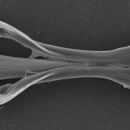en
names in breadcrumbs


Seison nebaliae lives only as epibiont on leptostracan crustaceans of genus Nebalia.
Seison nebaliae lives only as epibiont on leptostracan crustaceans of genus Nebalia. This species is unable to swim and can be regarded as a sessile epibiont which adheres firmly to its host. It maintains neck and foot withdrawn into the trunk while the host is moving; on the contrary all the body appears fully extended when the host is still. It can be hypothesized that the transfer to a new host one can occur or from Nebalia mother to offspring, when the juveniles are in the brood chamber, or between adult crustaceans when they are crowded in hiding places during the day, being Nebalia species nocturnal animals. However, it has never been reported how Seison transfers between hosts or during the crustacean moults. The stomach content of S. nebaliae consists of detritus and algae therefore the relationship with its host may be phoretic and/or commensal. Seison nebaliae is reported to occur, on the same host, together with the Paraseison annulatus. However the former lives on the pleopods while the latter attaches to pereiopods, to the edges of the carapaces and, occasionally, to the antennae and abdomen.
The species has been described on specimens collected near Trieste (North Adriatic Sea, Italy) Later on, S. nebaliae has been collected at Marseille (Mediterranean France), Naples (Italy), Venice Lagoon (Italy) and Majorca (Balearic Islands), at Roscoff (Atlantic France) in the English Channel (France and UK). It has been reported S. nebaliae also in the sea of the Sachalin Island (North Pacific Ocean).
Marine
The body can be divided into four parts: head, neck, trunk and foot. Neck and foot are segmented and can be retracted telescopically. Adult specimens are about 1 mm long, but it has also been reported a length of 2.5 mm for an adult male; usually, males are longer than females. At light microscope males are easily recognizable, because their cloacal opening is dorsal, at the anterior end of the trunk; in females, the cloaca is dorsal, but at the posterior end of the trunk. Moreover, males possess a longitudinal groove on the ventral side of their head. The head is oval and somewhat flattened laterally. The mouth opens apically in the middle of a small ciliated field, bilaterally lined by rows of ciliar tufts. Under the light microscope, immediately behind the mouth, can be observed the fulcrate mastax, the salivare glands, the oesophagus, the brain and the retrocerebral and subcerebral glands. On the head are located three sensorial organs (antennae) consisting of tuft of few short cilia: one antenna is dorsal, in the middle of the head; the other two are lateral. The fulcrate trophi have a very long fulcrum with a wide dorso-ventral end; rami present long posterior extensions (alulae) parallel to the fulcrum; the apical parts of the rami are covered by epifaringeal plates; unci are small, elongated, slightly bent and provided with one anterior major tooth and an additional, posterior tooth. The neck is long and is made of three pseudosegments, only the first one bears four rings. The neck containing excretory ducts, esophagous and muscles, can be withdrawn into the trunk. The trunk is oval, tapered caudally and flattened ventrally, with longitudinal folds. It contains the stomach sac, the very small intestine and a voluminous genital apparatus. Female genital apparatus consists of two sac-like ovaries in which growing eggs at different stages of maturation can be seen. The two ovaries join caudally in a short oviduct which ends in the cloaca, dorsal at the posterior end of the trunk. Male genital apparatus consists of two sac-like testes that join caudally in a complicate pear-shaped organ, containing the deferent duct and a voluminous seminal vesicle. The pear-shaped organ folds upwards, dorsal to the stomach, and reaches the cloaca, located dorsally at the beginning of the trunk. The foot is made of four pseudosegments and ends with an adhesive disc. In the foot are visible many ducts and glands of different lengths, most of these reach the adhesive terminal disc. The last pseudosegment is bent dorsally and possesses a ventral tubercle, which is the opening of a mucous gland.
Dioic species
About 1 mm